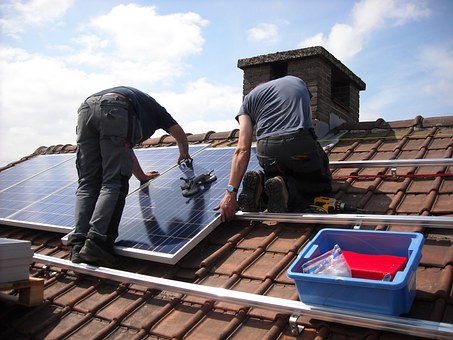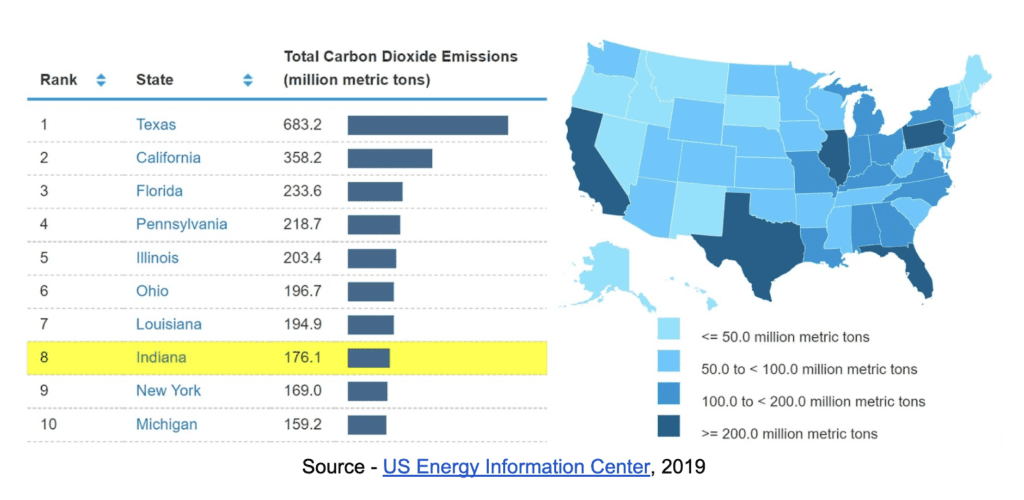
Indiana Needs Improvement on Climate Change
Indiana only generates 10% of its electricity from renewable sources.

Indiana was ranked as the 8th highest state for overall greenhouse gas emissions, emitting 176.1 million metric tons of carbon dioxide, outstripping the state’s population rank (17th). This is disheartening for anyone considering the societal costs and global instability from human-caused climate change.
Indiana only generated 10% of its electricity from renewable sources in 2021, mostly from wind power. Indiana currently uses four times more energy than is produced within the state. More energy could be generated locally with innovative state-level wind and solar energy policies.
Unfortunately, Indiana legislators phased out net metering for rooftop solar with a 2017 law. After that law was passed, residential solar installations dropped 93%.
The energy utility bill being considered in the 2023 Indiana legislative session, HB 1007, mentions environmental sustainability, but it is by far the weakest section. The bill does not mention climate change or set targets for reducing electric sector greenhouse gas emissions. The bill has no meaningful content that would increase the sustainability of energy generation or reduce the state’s greenhouse gas emissions.
Several amendments for HB 1007 were rejected. One proposed a return of solar net metering (Amendment 2 by Representative Matt Pierce), and the other introduced community solar (Amendment 1 by Representative Sue Errington).
Indiana State Representative Matt Pierce responded:
Among the many negative outcomes of phasing-out net metering is it undermined a fledgling industry that could grow in Indiana. By extending the payback period for an owner of a solar installation through lower payments for excess energy returned to the grid, the General Assembly made it less likely homeowners will install solar panels, reducing demand for solar installations. Instead, the legislature should enact policies to assist economic development in this industry.” Indiana’s energy policies should be working to accelerate the transition away from fossil fuels. Unfortunately, the Republican majority has only grudgingly accepted the fact that an energy transition is underway, and market forces are pushing the energy industry toward renewables. Key policymakers in the General Assembly refuse to discuss climate change, let alone enact policies that would combat it. The major piece missing from Indiana’s energy policy is the promotion of distributed energy like rooftop solar. Instead, it has been hostile to policies that might liberate Indiana ratepayers from their monopoly utilities. HB 1007 establishes some broad principles upon which everyone can agree, but it creates no policies that will put Indiana in the forefront of the energy transition.
Indiana is behind neighboring Illinois and Ohio for jobs in the solar energy sector, in part due to the 2017 law that phased out net metering. Thirty-nine states, including Ohio and Illinois, allow residents to use net metering (National Solar Jobs Census 2021). Net metering credits an electric utility customer with rooftop solar at the consumer cost of that electricity and spurs more installations.
Increased rooftop and community solar would also generate more Indiana power – within Indiana. While other states are moving into the next phase of renewable and sustainable energy technology in storage and grid upgrades, Indiana legislators are considering legislation to subsidize and build new fossil fuel plants (HB 1417).
What can one do?
Contact your Indiana State Senator, where the bill will go next. HB 1007 is co-sponsored by Indiana State Senator Eric Koch. Sign your household or business up for a renewable power alternative. One supplier, AES Indiana, notes that a “typical customer using 1,000 kWh per month enrolled at the 100% level [for renewable energy credits] would pay an additional $5.50 on their [monthly] AES Indiana electric bill.” Get a home energy audit and weatherize your home. Sealing leaks, improving insulation, and investing in high-efficiency lighting and appliances can significantly reduce a home’s energy use and energy bill. Learn about other utility and energy bills going through the Indiana state legislature, and comment on those. Here’s an article from IndyStar, Advocates Worry Energy Bills Give More Power to Utilities, Put Consumers at Risk. House Bill 1417, also sponsored by Representative Ed Soliday, would put ratepayers on the hook to subsidize new fossil fuel plants causing more climate change disruption.
Indiana Capital Chronicle is part of States Newsroom, a network of news bureaus supported by grants and a coalition of donors as a 501c(3) public charity. Indiana Capital Chronicle maintains editorial independence. Contact Editor Niki Kelly for questions: info@indianacapitalchronicle.com. Follow Indiana Capital Chronicle on Facebook and Twitter.




